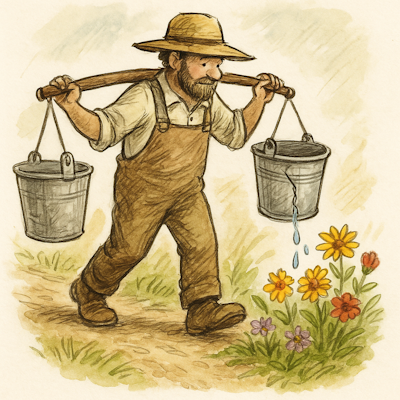The Farmer & The Two Buckets
Illustrates Psychological Safety, Appreciating Diverse Strengths, Continuous Improvement
Agile teams thrive when they recognize value in every contributor, even when a skill set or process seems "cracked". This parable reframes imperfections as hidden advantages and reminds us that progress often flows from diversity, reflection, and trust rather than uniform excellence.

A farmer carried two wooden buckets to the river each morning. One bucket was flawless. The other had a small crack that leaked water along the path back to the farmhouse.
After many months the cracked bucket felt ashamed. “I arrive only half full,” it sighed. “You should replace me.”
The farmer smiled. “Look at the edge of the path on your side.”
The bucket noticed a ribbon of bright flowers stretching from the river to the house.
“I planted seeds there,” the farmer said. “The water you lost each day nourished them. Those flowers decorate my table and sell at the village market. Without your crack, the path would be barren.”
The bucket realized its flaw had become a source of beauty and value.
Lessons Learned
Imperfections Can Drive Innovation
Agile work rarely begins with perfect code, flawless process, or identical skill levels. Cracks invite creativity, experimentation, and learning that uniformity cannot.
Outcomes Over Optics
The perfect bucket looked efficient, but the cracked bucket created additional value. Agile teams focus on customer impact rather than surface-level neatness.
Psychological Safety Unlocks Contribution
The farmer responded with curiosity and appreciation, not blame. Teams that feel safe explore weakness openly and turn it into collective strength.
Systems Thinking Beats Local Optimization
A leaky bucket looks like waste in isolation. In the wider system it irrigates flowers and extends product value. Agile leaders view work as interconnected flow, not isolated tasks.
Continuous Improvement, Not Replacement
Instead of discarding the bucket, the farmer integrated its limitation into the workflow. Agile organizations invest in learning and adaptation before they replace people or practices.
Coaching Tips
- Seed Reflection: Share the story during retrospectives focused on legacy code or uneven skills and ask, "Where might our cracks be watering flowers?"
- Pair the Buckets: Promote pair programming or mobbing so "perfect" and "cracked" teammates learn from each other and broaden perspectives.
- Spotlight Hidden Flow: Use the parable with leaders to shift talk from gap hunting to strength finding and reveal unseen value streams.
- Map Before Patching: When a process leaks efficiency, diagram the entire system first. You may discover benefits worth preserving.
- Celebrate Blooming Benefits: Publicly recognize small, unexpected gains to nurture morale and reinforce a culture of experimentation.
Agile excellence is not sterility. It is the art of channeling every quirk, constraint, and crack toward meaningful outcomes. Like the farmer, effective teams observe the whole path, nurture emergent value, and honor the unique contribution of every bucket they carry.


